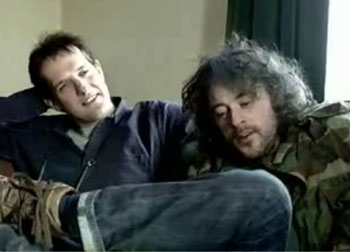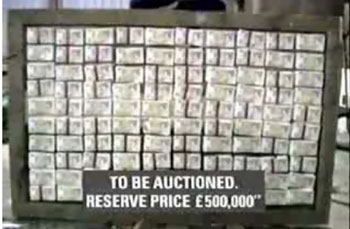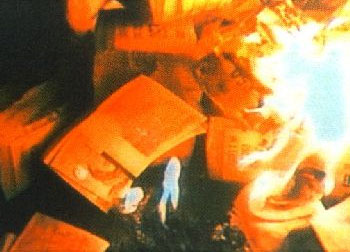The discussion about the positives and negatives of the cheap 50mm, around $100 for any camera platform in sub-2.0 focal lengths, has been picking up. Most recently, Fraser has chimed in, stating that he feels the 50mm lens is too long on an APS-C sensor. His essay goes on to say:
Where I differ from some photographic commentators is the noble notion that whatever was good enough for Robert Capa or Cartier-Bresson should be good enough for you and I. I strongly disagree with any claim along the line that prime lenses are somehow a purer expression of photography than zoom lenses. Yes, we all love elegant equipment and, heaven knows, the Leica M8 is burning a hole in my heart right now. However, the existence of historically important photographs taken with prime lenses only serves to disprove the counter-claim that zoom lenses are a necessary precondition to good photographs. It doesn’t prove anything much about the virtues of prime lenses.
I’m always a fan of the argument that the camera equipment used is less important than the wetware of the person holding the camera. Cartier-Bresson could probably outshoot me using an iPhone if he were still working today. However, I think that Fraser’s argument leaves out one important detail. In order to truly grok photography, and the range of possibilities that the equipment gives you for fulfilling your vision, you have to see what you can do with various combinations of the variables of focal length, aperture, exposure, and ISO. And, quite simply, most people with consumer grade equipment have never seen what they can do with an aperture wider than f/4.
For me, it’s not about whatever was good enough for the old masters is good enough for me. It’s more that I believe in order to learn what you can do, you need to explore the full effects of all the different settings you can use to make a photograph. And, in most cases at the consumer level, modern zoom lenses—while useful for their strengths—have taken away the ability to explore the wide end of the aperture range.
Let’s take an example of the Canon Rebel XTi which ships with a kit EF-S 18-55 f/3.5-5.6 lens. (Note: I’m only using Canon as an example here because that’s what I’m familiar with, but all of the major camera makers are in the same ballpark here, so translate as appropriate to Nikon, Sony, or what have you.) Using this lens at the wide side lets you get to f/3.5, but by the time you get to the long end of this lens, your largest aperture is f/5.6. Using these apertures, it’s hard to really utilize selective focus. Even if you step up a notch, the ~$500 EF-S 17-85 IS lens has a aperture range of f/4-5.6 which gives you about the same range of possibilities, albeit with higher optical quality.
I’m going to go on a limb here and state that to even start learning what kind of effect that aperture can have on your photography, you need to shoot for a while with a lens that can do at least f/2.8, a full stop faster than the previous two lenses on the wide side, and two stops faster on the long side. To do this with a zoom on a Canon camera means stepping up to the EF-S 17-55 f/2.8 IS lens. This is a very nice lens with a constant aperture of f/2.8 throughout its range. It’s also about a $1000. And, while for many purposes, a maximum aperture of f/2.8 is open enough, it’s still not really that open. It’s open enough to be useful most of the time, but as a learning tool, it’s still not quite there. It won’t expose you to what is really possible at larger aperture settings.
Complicating matters just a bit more, lenses typically aren’t at their best sharpness when set to their maximum aperture. You usually have to step down a stop to start getting into the sharpness sweet spot of a lens. Sometimes more. So, if you want to make really nice photos using a f/2.8 aperture, you really should be using a f/2.0 lens. And if you want to explore f/2.0, using a f/1.4 or f/1.8 lens is almost a must. Even if you want to explore f/4—within the range of the consumer grade zooms—you’ll want a lens that can do at least f/2.8.
This is why the 50mm f/1.8 is such a good learning tool for the price. For less than $100, a week or two’s worth of trips to Starbucks for some people, you can really see what wide open apertures can do for you. It’s over a stop faster than the $1000 EF-S 17-55 f/2.8 IS, and 2.5 to 3.5 stops faster than the $500 zoom and the kit zoom that comes with the Canon Rebel XTi.
Now, let’s look at the effect of the cropped sensor on the lens. It is true that with the 1.5-1.6 multiplier of the APS-C sized sensors in most digital SLRs, the 50mm lens results in an angle of view equivalent to a 70-80ish mm lens. This is neither a good or a bad thing. For some people, this makes the lens too tight for what they want to shoot. For others, it’s too far from the philosophical perfection of the “normal” lens, that is a lens that has the same focal length as the diagonal of the image capture area. And yet, for others, it’s starting to become a great focal length for capturing portraits. Many portrait photographers love the 85mm lens.
Let’s take the “normal” lens discussion a bit further. A 50mm lens, while the classic first lens for the 35mm format, is actually longer than the diagonal of the image area. If you really want a “normal” lens on a full frame 35mm image area, you’d need a 43mm lens. Except, nobody has ever made a 43mm lens, at least not that I’m aware of. The 50mm length became the standard because it was easier to make a sharp lens at slightly longer focal lengths when Leica created the first 35mm camera. To this day, 50mm lenses are characterized by a much simplier lens design than almost any other focal length for 35mm SLRs. That’s why the are among the least expensive lenses available.
For an APS-C sensor, the diagonal of the image area is 30mm. So, if you want the same angle of view as you get with a 50mm lens on a full-frame sensor, a 35mm lens will work just about perfectly. And, indeed, the 35mm has long been a favorite lens of many photographers. I’d have no problem recommending that a learning photographer pick one up so that they can learn the full range of photographic possibilities open to them with a digital SLR. There’s only one catch. 35mm lenses are much more expensive at equivalent maximum aperture values. A Canon EF 35 f/2 goes for about $250 and a Canon EF 35 f/1.4 L goes for over $1000. Equivalent Nikon glass is probably in the same general range.
After all that discussion, let’s focus back on the recommendation for the learning photographer who has a digital SLR and a kit lens. Here’s my slightly modified recommendation after all has been said:
I think you can do very well with either the 35mm f/2 or the 50mm f/1.8 lenses. Either one will teach you vast amounts about photography that you won’t be able to get from a kit lens or any zoom that costs less than $1000. And, the sub-$100 50mm is the cheapest way to get there, if budget is a concern. If you want to learn with about the same field of view as the standard lens on a full-frame camera and have $250 to spend, consider the 35mm f/2 lens as an alternative. Either way, you’ll do just fine.
You should hold off on getting those $1000 lenses anyway, whether they are primes or zooms, until you get an idea of where you want to take your photography. Lenses are part of the equation for expressing yourself photographically. You should first find out what kind of photography interests you and then build up the good equipment to support that. You may decide that you like using wide apertures, or you might decide that f/16 is for you. What you find through experiementation will guide your lens decisions as you build your photographic skill, and your lens collection.
Category: linked list (Page 43 of 52)
Fontometer [From Arial versus Helvetica | i love typography]
Johno from I love typography, in his latest article “Arial versus Helvetica”, shows us once again how to set the bar high with his innovative Fontometer
[From pinniped: The Locals]
designboom weblog, design related news, reviews and previews]
(via Monoscope)
Accessibility Links Skip to content Skip to bbc.co.uk navigation Skip to search Access keys help bbc.co.uk bbc.co.uk Navigation Search Home TV Radio Talk Where I Live A-Z Index UK versionInternational version|About the versions Low graphics|Accessibility help BBC News 24 News services Your news when you want it News Front Page World UK England Northern Ireland Scotland Wales Business Politics Health Education Science/Nature Technology Entertainment Also in the news —————– Video and Audio —————– Have Your Say Magazine In Pictures Country Profiles Special Reports RELATED BBC SITES SPORT WEATHER CBBC NEWSROUND ON THIS DAY EDITORS’ BLOG Last Updated: Tuesday, 2 October 2007, 11:57 GMT 12:57 UK E-mail this to a friend Printable version Fake £20 notes gang sent to jail Ringleader Thomas McAnea and deputy John McGregor Case background Six men have been jailed for their part in a counterfeiting fraud that could have destabilised the British economy. [From BBC NEWS | Scotland | Glasgow, Lanarkshire and West | Fake £20 notes gang sent to jail]
Interesting little article on the BBC of a counterfeiting group operating in Scotland.
Search Engine Journal Subscribe via RSS or email: Google Webmaster Tools: A Comprehensive Guide September 26th, 2007 by Eric Lander, Associate Editor | 2 Comments Web site owners and marketers have always craved more information with regards to how Google sees their site. Google Webmaster Tools address these and other needs as they provide support for those looking to diagnose errors, improve a site’s visibility and declare preferences on how to handle web site listings. Of course, before you can begin using Webmaster Tools, you will need to have an active Google Account. Once you have an account, you can get started by accessing: https://www.google.com/webmasters/sitemaps/ Verification Before you can get too far, you need to tell Google what sites you want to have controls over. Just enter the URL as prompted, and you’ll soon see that you need to verify your control of a site. You can choose to upload a blank HTML file, or, paste a META tag in your home page’s HEAD. Either way, [From Google Webmaster Tools: A Comprehensive Guide]
(via Matt Cutts)
Maybe it’s because I’m reading Blood Music at the moment, but I found this video of an enzyme unravelling the DNA strand of an attacking virus, in real-time, absolutely fascinating.
http://aimediaserver4.com/studiodaily/videoplayer/?src=ai4/harvard/harvard.swf&width=640&height=520
(Via We Make Money Not Art)
Print Edition | Subscribe NEWS POLITICS OPINIONS LOCAL SPORTS ARTS & LIVING CITY GUIDE JOBS CARS REAL ESTATE RENTALS CLASSIFIEDS SEARCH: washingtonpost.com Web | Search Archives washingtonpost.com > Health Print This Article E-Mail This Article E-MAIL NEWSLETTERS View a Sample and Sign Up Lean Plate Club Manage Your Newsletters Greening the Gear Bamboo Bikes and Sustainable Skateboards Put a New Spin on Sports By Kathleen Hom Washington Post Staff Writer Tuesday, September 11, 2007; Page HE01 From natural cleaning products to hemp clothing, the Green Revolution has transformed the contents of our kitchen cabinets and closets. Now, sporting and fitness goods manufacturers are taking the trend outdoors, marketing upscale products that boast a new sensitivity to the environments in which they are used. “When you paddle out [into the waves] and you see Styrofoam cups, plastic bags, cigarettes, what enters your mind is what you’re buying and . . . what you’re riding in the ocean [From Greening the Gear – washingtonpost.com](Via treehugger)
BB pal Michael W. Dean recently reminded us of the work of K Foundation, the UK anarcho-prankster duo who set about to become ginormous pop stars in the 1980s, and did just that as The KLF.
In 1988, members Bill Drummond and Jimmy Cauty self-published a book (“The Manual“) with step-by-step instructions on how anyone might do exactly the same: PDF Link to a copy of “The Manual.”
Here’s a snip from the Wikipedia entry for KLF:
From the outset, they adopted the philosophy espoused by esoteric novels The Illuminatus! Trilogy, gaining notoriety for various anarchic situationist manifestations, including the defacement of billboard adverts, the posting of prominent cryptic advertisements in NME magazine and the mainstream press, and highly distinctive and unusual performances on Top of the Pops. Their most notorious performance was at the February 1992 BRIT Awards, where they fired machine gun blanks into the audience and dumped a dead sheep at the aftershow party. This performance announced The KLF’s departure from the music business, and in May 1992 the duo deleted their entire back catalogue.
With profits earned from KLF, Drummond and Cauty created the K Foundation, with a mission to subvert the contemporary art world.
Among the hijinks that ensued: an alternative art award for the worst artist of the year, and burning a million British pounds in cash (about $1.8 million US at the time), which represented nearly all of their pop star earnings.
The odd process leading up to that torching, and the burn itself — which took place on a Scottish island in the summer of 1994 — are documented in the film K Foundation Burn a Million Quid.
You can watch that on the youtubes, in five parts, starting here: Video Link. Update: Thanks to the many BB readers who pointed out that the whole film is available in a single, less crappy quality, downloadable file on Google Video: Link.
[From KLF: Burn a Million Quid (video) and The Manual (e-book)]
When two planes from the “Zelazny” display team collided killing both pilots at a weekend airshow over Radom in Poland, photographer Kacper Pempel nailed the full horror of the crash in a sequence which takes us from the moment three three planes converge to the violence of the impact and the aftermath as debris and a few recognisable components seem to hang in the sky and then rain down like confetti around the crippled remains of one of the aircraft.
[From No Second Chance]



